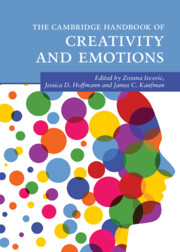Book contents
- The Cambridge Handbook of Creativity and Emotions
- Cambridge Handbooks in Psychology
- The Cambridge Handbook of Creativity and Emotions
- Copyright page
- Dedications
- Contents
- Figures
- Tables
- Contributors
- Acknowledgments
- Creativity and Emotions
- Part I Methods in the Study of Creativity and Emotions
- Part II The Development of Creativity
- Part III Emotions and the Creative Person
- Part IV Emotions and Creative Products
- Part V Emotions and Creativity at School and Work
- 24 Anxiety, Fear of Failure, and Creativity
- 25 Peers, Affect, and Creativity at School
- 26 Creative Curricular Experiences
- 27 Organizational Affective Climate and Creativity at Work
- 28 Group Affect and Creativity
- 29 Psychological Safety and Creativity
- 30 Leadership, Creativity, and Emotions
- 31 A Multilevel Model of Emotions and Creativity in Organizations
- 32 Creativity and Emotion
- Index
- References
25 - Peers, Affect, and Creativity at School
from Part V - Emotions and Creativity at School and Work
Published online by Cambridge University Press: 16 February 2023
- The Cambridge Handbook of Creativity and Emotions
- Cambridge Handbooks in Psychology
- The Cambridge Handbook of Creativity and Emotions
- Copyright page
- Dedications
- Contents
- Figures
- Tables
- Contributors
- Acknowledgments
- Creativity and Emotions
- Part I Methods in the Study of Creativity and Emotions
- Part II The Development of Creativity
- Part III Emotions and the Creative Person
- Part IV Emotions and Creative Products
- Part V Emotions and Creativity at School and Work
- 24 Anxiety, Fear of Failure, and Creativity
- 25 Peers, Affect, and Creativity at School
- 26 Creative Curricular Experiences
- 27 Organizational Affective Climate and Creativity at Work
- 28 Group Affect and Creativity
- 29 Psychological Safety and Creativity
- 30 Leadership, Creativity, and Emotions
- 31 A Multilevel Model of Emotions and Creativity in Organizations
- 32 Creativity and Emotion
- Index
- References
Summary
This chapter discusses the dynamic interplay of peer relationships and affect: factors that serve as drivers and consequences of creativity in the classroom. A particular focus is put on three problems inspired by research conducted in creativity and educational psychology literature. First, it is analyzed how creative students are perceived by their peers, i.e., whether being creative means being interpersonally attractive in the classroom. The benefits and risks of creative potential and behavior for peer relationships are overviewed based on sociometric and network studies. Second, school and class-based conditions of creative self-concept are analyzed. Drawing on the classic “big-fish-little-pond effect,” which shows that students tend to underestimate their potential in selective classroom environments, this chapter explores the extent to which this effect generalizes to creativity. Third and finally, the role of classroom creative climate, particularly teachers’ support and classroom interaction, to make creativity effective is emphasized.
- Type
- Chapter
- Information
- The Cambridge Handbook of Creativity and Emotions , pp. 479 - 497Publisher: Cambridge University PressPrint publication year: 2023



